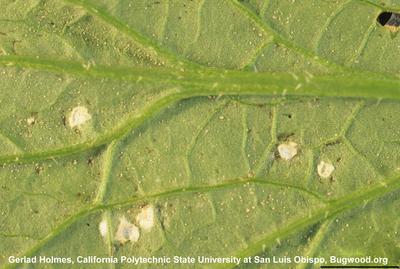White Rust
Albugo candida
Fungus
In a Nutshell
- Pale leaf spots develop into white, shiny raised pustules.
- Tiny powdery spores on the lower leafside.
- Stems and flowers also affected.
- Severely affected plant parts can shrivel and die.
Can also be found in
Symptoms
White rust can infect a plant both locally or systemically. Symptoms vary based on infection type. Local infection appears as blisters which in the early stages are seen on the underside of leaves, smaller stems and floral parts. Pustules measure approximately 1 to 2 mm in diameter and are white or creamy yellow. As symptoms progress, circular areas of light green to yellow discolouration appear on the upper leaf surface corresponding to white blisters on the lower side of the leaves. In systemic infections, the disease grows throughout the plant's tissue resulting in abnormal growth, distortion of affected plants or the formation of galls.
Recommendations

Organic Control
Use plant extracts of Neem, Onion and Garlic. The essential oil from Eucalyptus possess broad antifungal activities and is effective against white rust disease both at the leaf and stage head phase.

Chemical Control
Always consider an integrated approach with preventive measures together with biological treatments, if available. Use doses of Mancozeb or metalaxyl and mancozeb for seed treatment. Applications should be made to the soil and subsequently applied to the foliage. Frequency of applications would vary according to the lenght of crop and amount of rainfall experienced. In temperate environments a soil application and a minimum of 1-2 foliar applications during the crop cycle is suggested.
What caused it?
The foliar disease is caused by the fungus of Albugo or Pustula. On some plants, such as Brassicas, white blister and downy mildew may occur together. Blisters contain white powdery spores which are spread by the wind when released. Preferred conditions required for white rust germination ranges from 13°C to 25°C, leaf wetness for a minimum of two to three hours, and a relative humidity of over 90%, high soil moisture and frequent rains. Oospores in soil and sporangia from perennial weed hosts in the vicinity favour primary spread. The secondary spread is encouraged by wind-borne and rain splashed conidia (sporangia) or autonomous zoospores (insects) infecting neighbouring plants. It affects many species of Brassica family but also vegetable crucifers, ornamental plants and numerous weeds. The spores can remain in the soil for at least three years.
Preventive Measures
- Plant disease-free and certified seeds and use resistant varieties, if available.
- Practice deep ploughing and early sowing.
- Avoid close spacing of plants, which encourages high humidity and infection.
- Ensure good hygiene practices to reduce the risk of contamination.
- Remove affected plant parts, and dispose of severely infected plant material.
- Weed control and other sanitary measures should be employed.
- A three year crop rotation with non-cruciferous host plants is usually effective.



